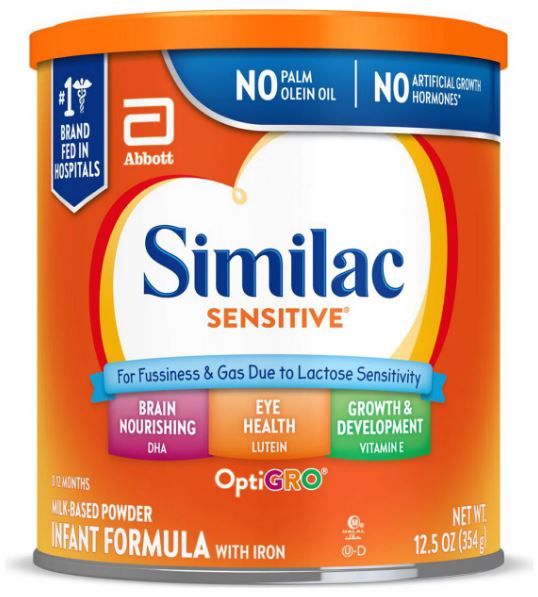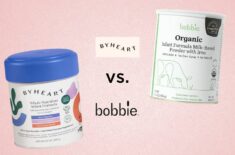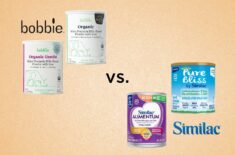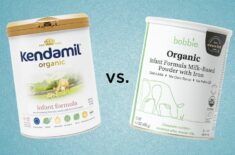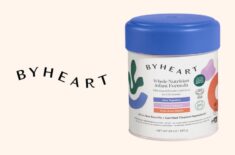Overview
Similac Pro-Sensitive Infant Formula and Enfamil Gentlease Infant Formula are made for babies with sensitive stomachs. Can both provide complete nutrition for your baby? Which one is better?
Finding the best baby formula can be a big challenge for parents, especially if your little one has a sensitive tummy and often experiences the following:
- Colic
- Fussiness
- Gas
- Acid reflux
- Spit-up
- Constipation
Some babies might also have lactose sensitivity or cow’s milk protein allergy.
Both Similac Pro-Sensitive and Enfamil Gentlease can be gentle formulas for your baby’s sensitive tummy. Learn more about these two formulas below.
Is Similac Pro Sensitive The Same As Enfamil Gentlease? Similarities & Main Differences
Similarities
Similac Pro-Sensitive and Enfamil Gentlease have the following similarities:
- Both formulas use Crypthecodinium Cohnii oil as a source of DHA (docosahexaenoic acid), an essential fatty acid for the brain’s growth and functional development. (1)
- Both have Mortierella Alpina oil as a source of ARA (arachidonic acid). This essential fatty acid can help promote a healthy immune system, better bone formation, and improve blood flow and blood vessel function. (2)
- Both have soy and dairy ingredients.
- Both have corn syrup.
- Both are formulated for fussiness and gas.
- Both can be prepared similarly and don’t require special preparation steps.
- Both sensitive formulas may provide complete nutrition with all the vitamins and minerals your baby needs during the first year.
- Both are available in different sizes and also in ready-to-use liquid formulations.
- Neither formula is specifically formulated for acid reflux.
- Neither formula is organic.
- Neither is a hypoallergenic formula.
These two formulas have the same amounts of the following nutrients, vitamins, and minerals:
- Vitamin B6: 60 mcg
- Choline: 24 mcg
- Vitamin A: 300 IU
- Vitamin D: 60 IU
- Iron: 1.8 mg
- Iodine: 15 mcg
Differences
Why Enfamil Gentlease Infant Formula Is Better
- This formula has a blend of easy-to-digest proteins for sensitive tummies.
- It costs slightly less than the Similac formula.
- It doesn’t have added sugar.
The Enfamil formula contains more of these nutrients, vitamins, and minerals:
- Proteins
- Vitamin E
- Vitamin K
- Vitamin B12
- Pantothenic acid
- Folic acid
- Vitamin C
- Magnesium
- Zinc
- Manganese
- Selenium
- Sodium
- Potassium
Why Similac Pro-Sensitive Infant Formula Is Better
- This formula contains 2’-FL HMO (2’-FL human milk oligosaccharide), an immune-nourishing prebiotic found at significant levels in breast milk.
- It contains lutein for better eyesight.
- It has nucleotides, which are important in the body’s metabolism functions. All cells in the body contain nucleotides.
- This formula is also formulated for mild spit-up.
- It doesn’t have palm olein oil which can lower calcium absorption in your baby’s tummy. (3)
- It’s certified to be non-GMO and free from artificial growth hormones.
- It’s completely lactose-free, while the Enfamil formula uses broken-down lactose proteins for a gentler formula.
- This formula hasn’t had any recall, but Enfamil Gentlease was recalled in 2006 due to possible contamination with metal particles. (4)
The Similac formula contains more of the following nutrients, vitamins, and minerals:
- Fats
- Carbohydrates
- Linoleic acid
- Thiamin (vitamin B1)
- Riboflavin (vitamin B2)
- Niacin
- Biotin
- Inositol
- Calcium
- Phosphorus
- Copper
- Chloride
Learn more about these sensitive formulas below.
Enfamil Gentlease Infant Formula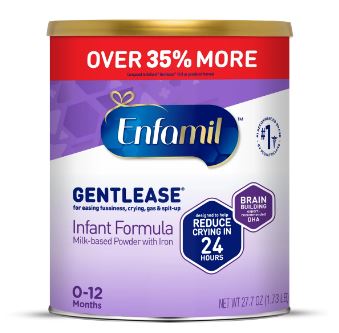




Best Features & Safety
- This formula contains easy-to-digest proteins that may be ideal for sensitive tummies.
Age Range
- This formula is for infants up to 12 months of age.
Ingredients
It contains the following ingredients:
- Corn syrup solids
- Partially hydrolyzed nonfat milk and soy (whey protein) concentrate solids
- Vegetable oil (palm olein, soy, coconut, and high oleic sunflower oils)
- Calcium phosphate
- Mortierella alpina oil (ARA source)
- Crypthecodinium cohnii oil (DHA source)
- Vitamin A palmitate
- Vitamin D3
- Vitamin E acetate
- Vitamin K1
- Thiamin hydrochloride
- Riboflavin
- Vitamin B6 hydrochloride
- Vitamin B12
- Niacinamide
- Folic acid
- Calcium pantothenate
- Biotin
- Ascorbic acid
- Choline chloride
- Inositol
- Calcium chloride
- Magnesium phosphate
- Ferrous sulfate
- Zinc sulfate
- Manganese sulfate
- Cupric sulfate
- Potassium chloride
- Potassium iodide
- Sodium selenite
- Sodium citrate
- Taurine
- L-carnitine
This milk formula is free from:
- Artificial flavors
- Artificial sweeteners
- Artificial colors
Nutritional Facts
Each 5 fl oz of this formula contains the following nutrients:
- Calories: 100 calories
- Total fats: 5.3 g
- Total carbohydrates: 10.8 g
- Added sugars: 0 g
- Proteins: 2.3 g
- Vitamin A: 300 IU
- Vitamin B6: 60 mcg
- Vitamin C: 12 mg
- Vitamin D3: 60 IU
- Vitamin E: 2 IU
- Vitamin K: 9 mcg
- Iron: 1.8 mg
- Calcium: 82 mg
- Linoleic acid: 800 mg
- Thiamin (vitamin B1): 80 mcg
- Riboflavin (vitamin B2): 140 mcg
- Vitamin B12: 0.3 mcg
- Niacin: 1,000 mcg
- Folic acid: 16 mcg
- Pantothenic acid: 500 mcg
- Biotin: 3 mcg
- Choline: 24 mg
- Inositol: 6 mg
- Vitamin A: 300 IU
- Phosphorus: 46 mg
- Magnesium: 8 mg
- Zinc: 1 mg
- Manganese: 15 mcg
- Copper: 75 mcg
- Iodine: 15 mcg
- Selenium: 2.8 mcg
- Sodium: 36 mg
- Potassium: 108 mg
- Chloride: 63 mg
Product Recall
Mead Johnson (the makers of Enfamil) issued a recall for Gentlease powdered infant formula in February 2006 for possible contamination with metal particles of up to 2.7 mm in size. (4)
This recall affected just one lot of the powdered formula but didn’t include the ready-to-use liquid formulation. (4)
Affected consumers were advised to check the powdered formula they bought if it has the following information at the bottom of the container: (4)
- Lot number BMJ19, with best before date code of “1 Jul 07.”
According to the FDA’s recall advisory, in the rare instance that your baby inhaled the formula and it reached their lungs, the metal contaminants may cause serious risks to the child’s throat and respiratory system. (4)
Injuries or symptoms associated with this recall issue are likely to show up within four hours after drinking the formula: (4)
- Coughing
- Breathing difficulties
- Swallowing difficulties
Those affected by this recall should immediately stop using the product. Mead Johnson advised them to seek further assistance at 888-587-7275. (4)
According to Mead Johnson, around 41,464 cans had been distributed to retail stores in the US starting from December 16, 2005. (4)
No health incidents or illnesses were reported concerning this formula recall. (4)
Pros
- This formula may be easier to digest because of the smaller broken-down proteins in its formulation.
- It has a thinner consistency that can make it easier to dissolve than the Similac formula.
Cons
- It contains palm olein oil which may affect calcium absorption. Less calcium may be absorbed by your baby’s body when this oil is present. (3)
- It has vegetable oils and corn syrup.
What Customers Say: Positive Reviews
“My daughter was getting such an upset tummy on her other formula and when we switched she had been a much happier baby.” – Reviewer on Enfamil’s website.
“We tried several formulas before finding Enfamil Gentlease. It’s been very helpful for her. She used to cry all the time after feedings and would spit up a ton. This formula seemed to help alleviate a lot of that. We love the formula itself, but the plastic tops were broken on both cans that we ordered and the scoopers were at the bottom of both cans. We needed to use tops and scoopers from previous cans.” – Reviewer on Amazon.
“This stuff has been life changing for my colicy daughter. Her gassiness and reflux dramatically improved within 24 hours of transitioning to Gentlease. Otherwise, it’s formula. It mixes easily in water, needs to be eaten shortly after being made, etc.” – Reviewer on Amazon.
What Customers Say: Negative Reviews
“Have been using this formula for my baby to help with fussiness and crying and I have actually seen the opposite. My baby seems to cry more and the formula does not seem to fill him up, he want to eat nonstop. I wouldn’t purchase this specific formula, I would rather stick to the general Enfamil products.” – Reviewer on Target.
“My baby made face anytime it was time for a feed. I decided to try it and it was awful! The milk taste really bitter or as if it was contaminated.” – Reviewer on Enfamil’s website.
“This formula us not gentle at all. My baby would get fussy after eating and would not finish his bottle each time with was usually around 2 to 3 oz I would have to throw out. He also would get gassy and constipated too. It is not worth the price for the hassle it caused.” – Reviewer on Enfamil’s website.
Similac Pro-Sensitive Infant Formula
Best Features & Safety
- It has the immune-nourishing prebiotic 2’-FL HMO (2’-FL human milk oligosaccharide) that’s found at significant levels in breast milk.
- It has lutein to help promote better eyesight for your baby.
- It contains nucleotides, which are important building blocks in the body and can help in metabolic functions.
Age Range
- This formula is made for infants up to 12 months old.
Ingredients
It contains the following ingredients:
- Corn syrup
- Milk protein isolate
- High oleic safflower oil
- Sugar
- Soy oil
- Coconut oil
- Crypthecodinium cohnii oil
- Mortierella Alpina oil
- 2′-fucosyllactose
- Short-chain fructooligosaccharides
- Beta-carotene
- Lutein
- Potassium chloride
- Sodium citrate
- Calcium phosphate
- Potassium citrate
- Soy lecithin
- Inositol
- Magnesium phosphate
- Ascorbic acid
- Choline chloride
- Ascorbyl palmitate
- Ferrous sulfate
- Choline bitartrate
- Taurine
- Calcium carbonate
- Zinc sulfate
- L-carnitine
- Mixed tocopherols
- Niacinamide
- D-alpha-tocopheryl acetate
- Calcium pantothenate
- Magnesium chloride
- Vitamin A palmitate
- Copper sulfate
- Thiamine hydrochloride
- Riboflavin
- Pyridoxine hydrochloride
- Folic acid
- Potassium iodide
- Manganese sulfate
- Phylloquinone
- Biotin
- Sodium selenate
- Vitamin D3
- Vitamin B12
- Potassium hydroxide
- Nucleotides (adenosine 5’-monophosphate, cytidine 5’-monophosphate, disodium guanosine 5’-monophosphate, and disodium uridine 5’-monophosphate)
This milk brand is free from:
- GMOs
- Artificial growth hormones
- Lactose
Nutritional Facts
Each serving (5 fl oz) of this formula contains the following nutrients:
- Calories: 100 calories
- Total Fats: 5.4 g
- Total Carbohydrates: 10.9 g
- Proteins: 2.1 g
- Vitamin A: 300 IU
- Vitamin B6: 60 mcg
- Vitamin C: 9 mg
- Vitamin D3: 60 IU
- Vitamin E: 1.5 IU
- Vitamin K: 8 mcg
- Iron: 1.8 mg
- Calcium: 84 mg
- Linoleic acid: 1,000 mg
- Thiamin (vitamin B1): 100 mcg
- Riboflavin (vitamin B2): 150 mcg
- Vitamin B12: 0.25 mcg
- Niacin: 1,050 mcg
- Folic acid: 15 mcg
- Pantothenic acid: 450 mcg
- Biotin: 4.4 mcg
- Choline: 24 mg
- Inositol: 24 mg
- Vitamin A: 300 IU
- Phosphorus: 56 mg
- Magnesium: 6 mg
- Zinc: 0.75 mg
- Manganese: 5 mcg
- Copper: 90 mcg
- Iodine: 15 mcg
- Selenium: 2 mcg
- Sodium: 30 mg
- Potassium: 107 mg
- Chloride: 65 mg
Product Recall
There have been no recalls for Similac Pro-Sensitive. But several formulas from the Sensitive line were part of a massive Similac recall in 2010 due to possible contamination with the small common beetle: (5)(6)
- Similac Advance Sensitive Powder DHA/AHA
- Similac Sensitive with Iron Powder
- Similac Sensitive R.S. Powder
- Similac Sensitive Early Shield Powder
Ingestion of the adult beetle or larvae may cause intestinal discomfort, or the child might refuse to eat, but it doesn’t pose an immediate health risk. (5)
Pros
- It doesn’t have palm olein oil, a compound that can inhibit proper calcium absorption in your baby’s body. (3)
- It’s also formulated for mild spit-up.
Cons
- It’s slightly more expensive than the Enfamil formula.
- It contains added sugar.
- It contains corn syrup and vegetable oils.
What Customers Say: Positive Reviews
“Our baby was colicky and used to spit up frequently. But, not any more. After using Similac Pro-Sensitive, she is doing great for the past three months. She never had any problems with digestion or gas after using Pro-sensitive and we continue to use. Mixing is super easy too. The only issue we have is the infrequent coupons that we receive as they are sent only once in month but baby needs one bottle each week as she is not breast feed. If we get few more coupons it would be helpful as good products like Similac are definitely expensive for us.” – Reviewer on Similac’s website.
“My bay is lactose intolerant and this is the only formula he won’t throw up.” – Reviewer on Amazon.
“My daughter was started on this formula after I ended breastfeeding and she never had any troubles with it. Ya the price is more than others, but I think that it’s worth it. Will use it with my next baby as well!” – Reviewer on Target.
What Customers Say: Negative Reviews
“Tried this for my 4 month old who had been experiencing really bad constipation and gas. He’s been on Pro advance since he was 10 weeks old. And the day I started him on it he would spit up after every feed more than usual and so I stopped it and now he’s projectile vomiting. 10/10 do not recommend.” – Reviewer on Similac’s website.
“The formula has definitely changed. I’ve used this for both my kids but as of recently I’ve noticed that the powder now dissolves incredibly fast. Anyone who makes 6-8 oz bottles would notice the difference, it’s significant. I know there’s been supply and distribution issues with everything lately. So I’m worried that some type of filler has been added. Thankfully my baby is turning one soon and we will no longer purchase. But still very concerning!” – Reviewer on Target.
“I’ve been trying to find the right formula for my 3 month old after I stopped breastfeeding. This particular similar formula has been awful for my baby. It gave her more gas, made her so fussy, and the poor thing could not sleep well EVER. She kept curling up her stomach in pain after being fed this formula. We did as recommended and tried it for 3 days to see if the issues would pass, but the issues remained. We are upset we spent money on this formula! We have been up every night trying to comfort our baby after this formula nightmare. Needless to say we stopped using it and found something better.” – Reviewer on Similac’s website.
Summary & Recommendation
There are many similarities between Similac Pro-Sensitive and Enfamil Gentlease Infant Formulas. But which one should you choose?
These milk formulas have omega 3 DHA, ARA, iron, choline, calcium, and other essential nutrients.
Both are from well-known formula brands and are formulated for fussiness and gas.
These formulas can provide your child with complete nutrition up to 12 months of age. Any option can be good for your child, but you can use the following recommendations for picking the right formula for your baby:
Choose Enfamil Gentlease Infant Formula if:
- You prefer a formula with easy-to-digest proteins for your baby’s sensitive tummy.
- You are looking for a cheaper sensitive formula.
- You prefer a formula with more vitamins C, E, K, and folic acid.
- You want to give your baby formula without added sugars.
Choose Similac Pro-Sensitive Infant Formula if:
- You’re looking for a completely lactose-free formula (the Enfamil formula uses broken-down lactose proteins, so it’s not entirely lactose-free).
- You prefer a formula with prebiotics similar to those in breast milk, such as 2’-FL HMO (2’-FL human milk oligosaccharide).
- You prefer a formula with lutein to promote better eye development.
- You might want to have one that has nucleotides, the building blocks of nucleic acids in your baby’s body.
- You prefer a formula for mild spit-up that doesn’t have palm olein oil so it can better promote calcium absorption in your baby’s tummy. (3)
- You want a formula that’s certified to be non-GMO and free from artificial growth hormones.
- You want a formula that contains more calcium, linoleic acids, copper, and carbohydrates.
Similac Pro-Sensitive Vs. Similac Sensitive
Similac Pro-Sensitive Infant Formula
Similac Sensitive
- These two have a similar formulation and contents.
- Both are formulated for fussiness and gas due to lactose sensitivity.
- They also have OptiGRO, an exclusive blend of lutein, DHA, and vitamin E. These are important ingredients found in breast milk that can support your baby’s brain and eye development.
What Makes Similac Pro-Sensitive Better:
- It has the prebiotic 2’-FL HMO (2’-FL human milk oligosaccharide).
- They both have the same nutrient, vitamin, and mineral content, except for inositol. Similac Pro-Sensitive has more inositol (24 mg) than Similac Sensitive (4.3 mg).
What Makes Similac Sensitive Better:
- Similac Sensitive is slightly cheaper than Similac Pro-Sensitive.
Which One Is Better Enfamil Or Similac? Similac Sensitive Vs Enfamil Gentlease
Similac Sensitive
Enfamil Gentlease Infant Formula




Similac Sensitive and Similac Pro-Sensitive have nearly identical contents and features, except for the inositol and 2’-FL HMO.
So, the similarities and differences between Similac Sensitive and Enfamil Gentlease are also nearly identical to our comparison between Similac Pro-Sensitive and Enfamil Gentlease above.
The only differences from the Similac Pro-Sensitive and Enfamil Gentlease comparison are:
- Both Similac Sensitive and Enfamil Gentlease don’t have 2’-FL HMO.
- Enfamil Gentlease has more inositol (6 mg) than Similac Sensitive (4.3 mg).
- Similac Sensitive is cheaper than Enfamil Gentlease.
Enfamil Gentlease Vs. Enfamil Neuropro Gentlease
Enfamil Gentlease Infant Formula




Enfamil Neuropro Gentlease




These two milk products have similar formulations and nearly identical contents.
What Makes Enfamil Neuropro Gentlease Better:
- It contains whey protein-lipid concentrate (milk) as a source of MFGM (milk fat globule membrane). This naturally occurring membrane is found in breast milk and may support your baby’s cognitive development.
- It has higher levels of inositol (24 mg) and sodium (40 mg) compared with Enfamil Gentlease (6 mg and 36 mg, respectively).
What Makes Enfamil Gentlease Better:
- It has more linoleic acid content (800 mg) than Enfamil Neuropro Gentlease (780 mg).
- It costs slightly less than Enfamil Neuropro Gentlease.
Similac Pro-Sensitive Vs. Enfamil Neuropro Gentlease
Similac Pro-Sensitive Infant Formula
Enfamil Neuropro Gentlease




These two formulas have similar content and can provide complete nutrition for your baby. They also have nearly identical similarities and differences with the Similac Pro-Sensitive vs. Enfamil Gentlease comparison.
What Makes Similac Pro-Sensitive Better:
- It has the prebiotic 2’-FL HMO.
- Similac Pro-Sensitive costs slightly less than the Enfamil Neuropro Gentlease.
What Makes Enfamil Neuropro Gentlease Better:
- It has MFGM (milk fat globule membrane), a component in breast milk that supports your baby’s cognitive development.
Factors To Consider In Choosing A Sensitive Formula
There are many reasons why you might want or need to give a sensitive formula to your baby. You’ll also find many options to choose from, especially if your baby is lactose intolerant or has cow’s milk allergies.
Here are some factors to consider:
Lactose-Free Formulas
Some babies might have difficulty digesting lactose because they lack the enzyme lactase in their tummies; this enzyme breaks down lactose (a type of sugar).
Lactose-free formulas are still based on dairy milk sources but have been processed to remove the sugar so babies with sensitive stomachs can digest it better.
Example of a lactose-free formula:
Reduced Lactose Formulas
Instead of fully removing lactose, these formulas simply break down the sugar for easier digestion.
Example of a reduced lactose formula:
Formulas With Probiotics & Prebiotics
Some formulas add probiotics (live bacteria for better gut health), prebiotics (a type of fiber used as food for probiotics), or a combination of both.
Such formulations may make it easier for your babies to digest the formula they drink.
Example of formula with a mix of probiotics and prebiotics:
Dairy-Free Formula
Dairy-free formulas are often confused with lactose-free formulas, but they’re different:
- Lactose-free formulas are still from dairy sources, but they’re processed to remove the lactose (sugar).
- Dairy-free formulas come from non-dairy sources such as soy and grains.
Dairy products might not be suitable for your baby’s tummy, especially if they have cow’s milk protein allergy or other medical issues. Some parents also choose non-dairy products due to ethical concerns or dietary preferences.
Dairy-free formula options include:
- Earth’s Best Non-GMO Soy-Based Infant Powder Formula
- Enfamil ProSobee Soy-Based Infant Formula
- Similac Soy Isomil Infant Lactose Free Formula
Hypoallergenic Formula
Some babies might need a hypoallergenic formula if they are allergic to any component in regular formulas, such as:
- Cow’s milk protein allergy
- Soy allergy
Some examples of hypoallergenic formulas are the following:
Texture/Thickness
If your baby frequently experiences acid reflux or spit-up, you can give them thicker formulas.
Some examples are:
Components That Resemble Breast Milk
Most baby formulas are made from cow’s milk, but some are specially formulated to resemble breast milk as closely as possible. It may be achieved by adding components that are abundant in breast milk.
Examples of these products:
- Similac Pro-Sensitive contains 2’-FL HMO (2’-FL human milk oligosaccharide), a prebiotic found at significant levels in breast milk. It also has OptiGRO, a blend of DHA, lutein, and Vitamin E.
- Similac Pro-Total Comfort Non-GMO Infant Formula Powder also has 2’-FL HMO prebiotics and the components of OptiGRO.
- Similac Pro Advance also features OptiGRO components and 2’-FL HMO prebiotics.
- Enfamil Neuropro Gentlease contains MFGM (milk fat globule membrane), a naturally occurring membrane in breast milk that can support cognitive development.
- Enfamil Enspire has MFGM and lactoferrin, a key protein found in colostrum and breast milk.
- Gerber Good Start Soothe (HMO) contains human milk oligosaccharides and probiotics.
Minimum Requirements And Safety Concerns
In choosing your baby’s formula, it’s important to make sure that it meets the minimum requirements set by the FDA, particularly concerning important components such as iron content.
The FDA requires at least 1 mg of iron per 100 calories of infant formula. Babies given formula with less than this requirement may need iron supplements to prevent iron deficiency anemia. (7)
It’s also important to check for recent formula recalls or safety issues.
Consult with your pediatrician if you plan on switching to a new formula.
Baby Formula FAQs
Do I Need To Choose Non-GMO Or Organic Formulas?
We recommend non-GMO and organic formulas. These are often more expensive than regular formulas, but they may be a safer, healthier alternative to heavily processed commercial products.
They’re free from:
- Pesticides
- Herbicides
- Antibiotics
- Growth hormones
- Genetically modified organisms
But parents aren’t required to buy these kinds of food products.
Is Corn Syrup Harmful?
Some baby formulas use corn syrup as a replacement for lactose. It may be easier to digest and can provide your baby with energy.
The corn syrup used in formulas is different from high-fructose corn syrup used to sweeten foods like soft drinks and commercial cookies.
Still, some parents prefer to give their babies formula free from any corn syrup, such as:
- Else Plant-Based Complete Nutrition for Toddlers
What Are The Symptoms Of Lactose-Intolerance In Babies?
It’s rarely life-threatening, but lactose intolerance can cause great discomfort to your baby.
You might notice these symptoms appear about 30 minutes to two hours after your baby drank formula or ate foods containing lactose: (8)
- Diarrhea or loose stools
- Nausea
- Vomiting
- Fussiness
- Stomach cramps
- Bloating
- Gas or flatulence
- Frequent crying
Consult with your pediatrician if your child frequently experiences these symptoms. (8)
What Are The Symptoms Of Cow’s Milk Protein Allergy?
Aside from causing discomfort to your child, cow’s milk protein allergy is also potentially life-threatening. (9)
A mild allergic reaction may lead to these symptoms: (9)
- Rashes
- Hives
- Itching
- Swelling
A severe allergic reaction to cow’s milk protein can cause: (9)
- Breathing trouble
- Wheezing
- Nausea
- Loss of consciousness
- Possible death in rare, extreme cases
The good news is that around 75% of children may outgrow cow’s milk allergy. Many can also tolerate baked forms of cow’s milk. But make sure to speak with your pediatrician before trialing this at home. (9)
Should I Feed A Gassy Baby Differently?
If your baby is gassy, you might try burping them more often during feeds. It can help prevent gas build-up in their little tummies.
Sometimes, changing your baby’s bottle to an anti-colic one, such as the Comotomo Baby Bottles or Dr. Brown’s Anti-Colic Bottles can do the trick.
If your baby is still gassy despite these changes, you can try choosing a different formula. Some examples are:
- Similac Pro-Sensitive Infant Formula
- Similac Sensitive Infant Formula
- Enfamil Gentlease Infant Formula
- Enfamil NeuroPro Gentlease Baby Formula
- Gerber Good Start Soothe Non-GMO Powder Infant Formula
- Enfamil Nutramigen Hypoallergenic Colic Baby Formula
- Earth’s Best Organic (Reduced Lactose) Sensitivity Infant Powder Formula with Iron
When Do Babies Outgrow Fussiness And Gassiness?
Babies develop and grow at a different rate. But many babies can outgrow their fussiness or gassiness by the time they reach six months of age.
Should I Give Water In Between Bottles?
No. Don’t give your baby water in between bottles, particularly if they are less than six months old. Babies need to get all their nutrition and liquids from breast milk or formula. (10)
You can offer water for infants six months and above, but you still need to limit water intake to around 4-8 ounces per day until they’re a year old. (10)
Children 1-3 years old can drink up to four cups of liquids (any liquid including milk and water) per day. (10)
How Will I Know If My Child Doesn’t Like A Formula?
A baby who doesn’t like a certain formula might do this:
- Turn away from the bottle
- Cries or becomes fussy while drinking
- Doesn’t finish the bottle
What Are The Signs That My Baby Needs A Different Formula?
Some of the signs that your baby might need a different formula:
- Frequently rejects the bottle
- Cries a lot despite regular and frequent feedings
- Spits up a lot
- Has streaks of blood in stool
If your child develops a rash, has difficulty breathing, and becomes lethargic after feeding, consult your pediatrician immediately. These are possible signs of a severe allergic reaction and could be life-threatening.
Can I Make My Own Formula?
No. The FDA doesn’t recommend making infant formulas at home because such could lead to potentially very serious health concerns. (11)
The FDA regulates commercially available infant formulas but not homemade formulas. However, the government agency reminds parents that safety should be your prime concern when choosing foods and formula for your baby. (11)
Errors in selecting and combining certain ingredients can lead to unsafe formulas that can harm your child. Feeding your child with homemade formulas may also cause severe nutritional imbalances. (11)
Can I Feed My Baby Pure Cow’s Milk?
No. While formula comes from cow’s milk, it’s already processed to be as close to human breast milk as possible. Pure or whole cow’s milk contains high levels of phosphorus and potassium that infant kidneys can’t process. (12)
Which Similac Is Comparable To Enfamil Gentlease?
Gentlease may be similar to Similac Pro-Sensitive and Similac Pro-Total Comfort.
Is Similac Sensitive Good For Acid Reflux?
It’s not formulated for acid reflux. Instead, you can try Enfamil AR or Similac for Spit-Up, with your pediatrician’s approval.
REFERENCES
(1) https://pubmed.ncbi.nlm.nih.gov/10479465/
(2) https://www.ncbi.nlm.nih.gov/pmc/articles/PMC4848685/
(3) https://pubmed.ncbi.nlm.nih.gov/8780336/
(4) https://www.aappublications.org/content/27/2/2006195
(5) https://buffalonews.com/news/similac-recalls-powdered-formula/article_a7d6e134-56bc-56c7-b29d-11edd4093b1e.html
(6) https://www.cbsnews.com/htdocs/pdf/SimilacLotList.pdf
(7) https://www.fda.gov/safety/recalls-market-withdrawals-safety-alerts/able-groupe-recalling-products-labeled-infant-formula-formulas-have-insufficient-iron-levels
(8) https://www.mayoclinic.org/diseases-conditions/lactose-intolerance/symptoms-causes/syc-20374232
(9) https://www.foodallergy.org/living-food-allergies/food-allergy-essentials/common-allergens/milk
(10) https://www.healthychildren.org/English/healthy-living/nutrition/Pages/Choose-Water-for-Healthy-Hydration.aspx
(11) https://www.fda.gov/food/people-risk-foodborne-illness/questions-answers-consumers-concerning-infant-formula#2
(12) https://www.ncbi.nlm.nih.gov/pmc/articles/PMC2791650/




